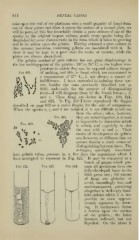Page 804 - My FlipBook
P. 804
814 DENTAL CARIES.
take upon the end of our platinum wire a small quantity of fungi from
one of these points and draw it across the surface of a second plate, we
will in parts of this line invariably obtain a pure culture of one of the
species in the original impure culture, nearly every species being dis-
tinguished by some characteristic in the form which it takes in growing
and in its action upon the gelatin. Having obtained a pure culture in
this manner, test-tubes containing gelatin are inoculated M'ith it. In
these it may be kept in a pure state for weeks or months, while the
plates are always short-lived.
The gelatin method of pure culture has one great disadvantage in
the low melting-point of the gelatin : 24° to 25° C. is the highest tem-
perature to which they can be exposed without danger
of melting, and this, to fungi which are accustomed to
a temperature of 37° C, is not always a matter of
indifference. I have succeeded in isolating three spe-
cies besides the ones previously described (see p.
802), and—only for the purpose of distinguishing
them—I will designate them by the Greek letters y, o,
and £. These fungi are shown in Figs. 420, 421,
and 425. In Fig. 419 I have reproduced the fungus
described on page 802 as a caries fungus, for the sake of comparison.
When the species a, y, and o are isolated, it is not difficult to tell one
from the other ; Mhen, however.
Fig. 421. they are mixed together, it is next
^^%g @f® & to impossible to determine which
Fig. 420.
VJ*^^^^' *^ which, and especially is this
:t
the ca.se with a and y. Their
"'n modes of development on gelatin
are, however, so different that we
possess therein a ready means of
distino;ui.shino; between them. The
a-fungus, sparingly inoculated
into gelatin tubes, presents in a few days the appearance which I
have attempted to represent in Fig. 422. It may be compared to a
bunch of grapes which pre-
Fig. 422. FiG. 423. Fig. 424. sents all gradations from the
fully-developed berry to the
little green one ; the masses
of fungi are globular or
ovoid, exceedingly fine, and
semi-transparent, presenting
altogether a strikingly beau-
tiful culture which it is im-
possible to even approx-
imately represent by draw-
ing. It furthermore forms
a button upon the surface
of the gelatin ; the latter
becomes softened, but not
liquefied. On the plates it


